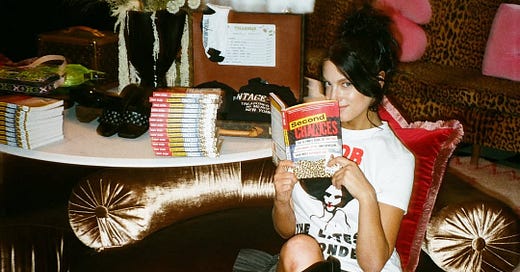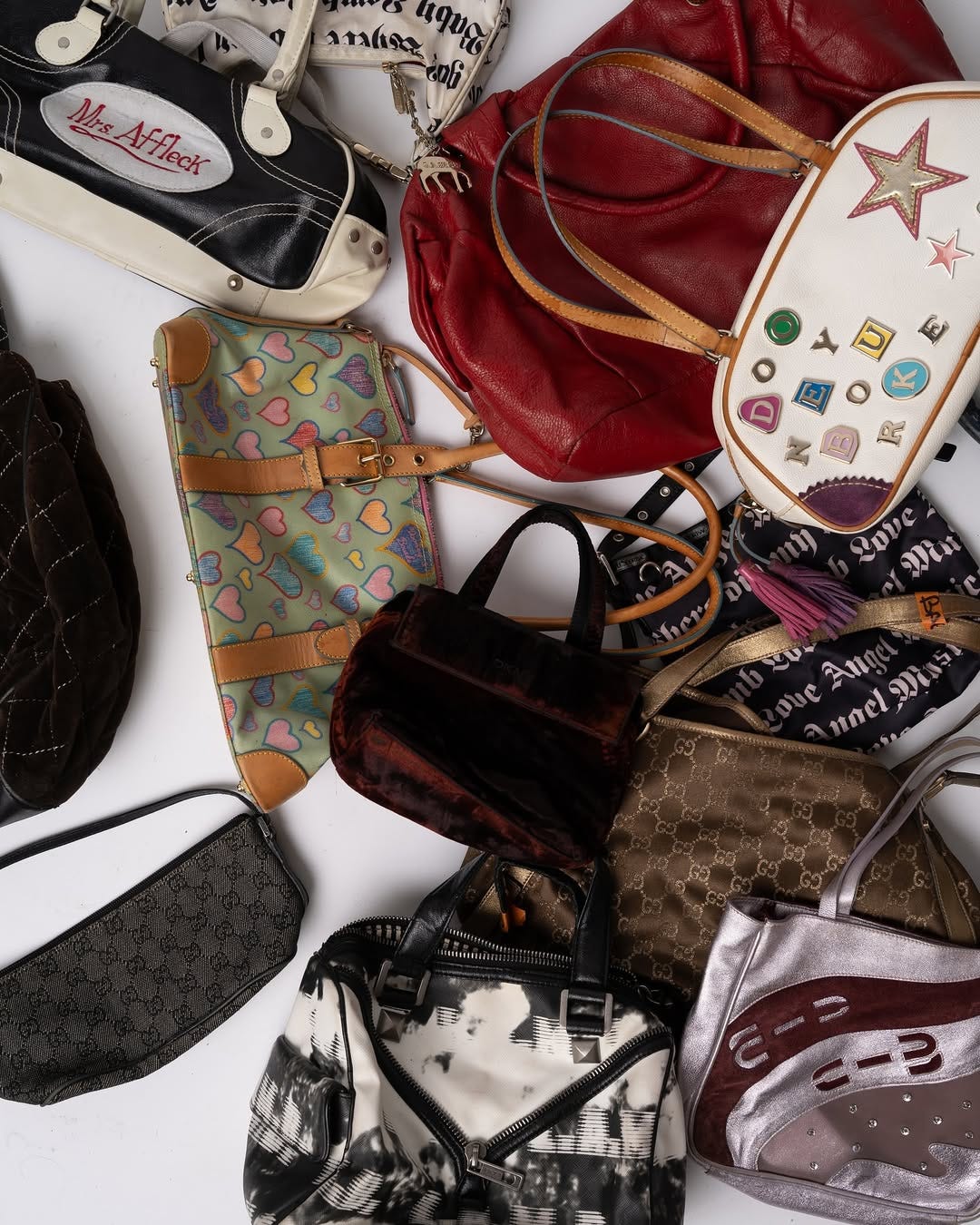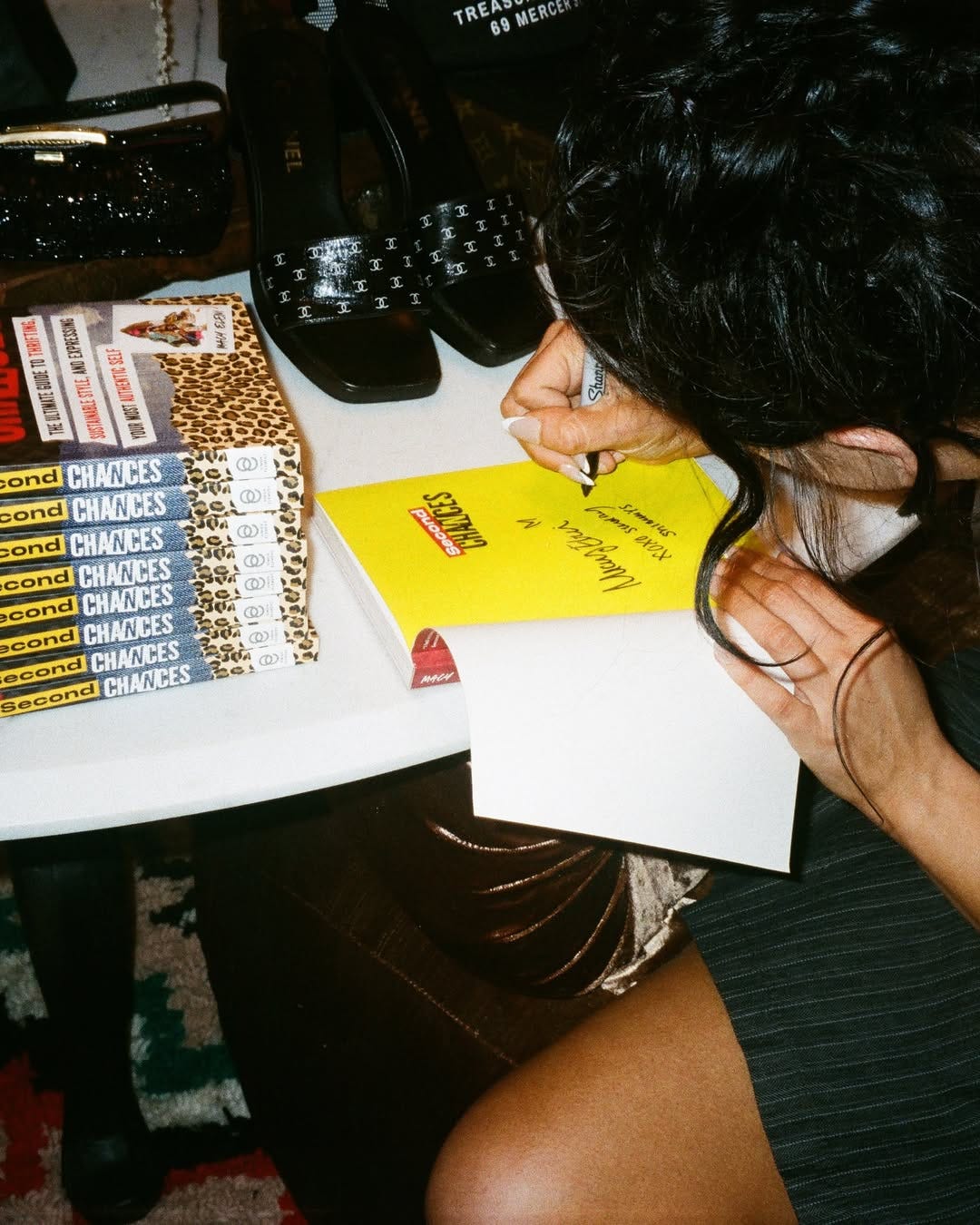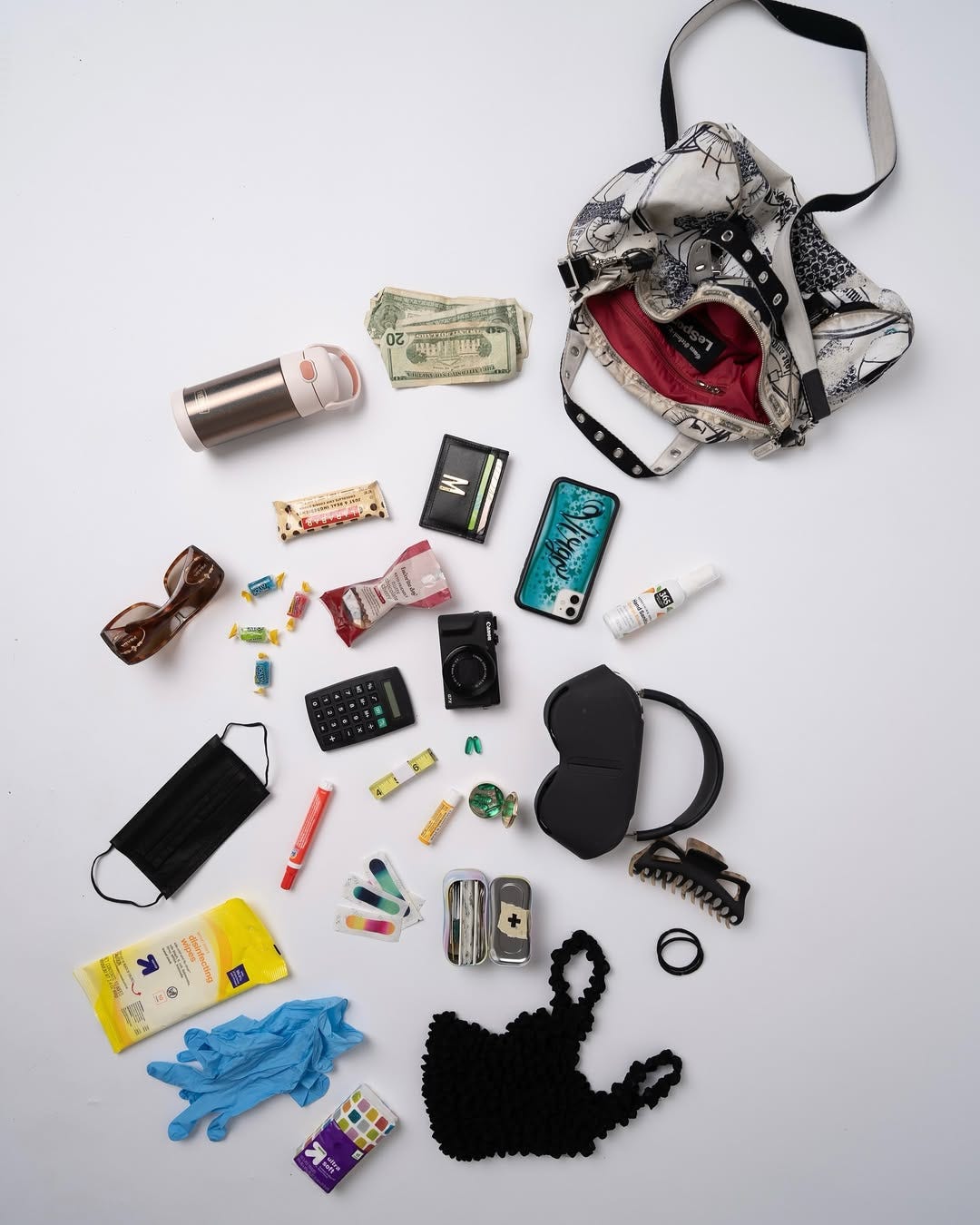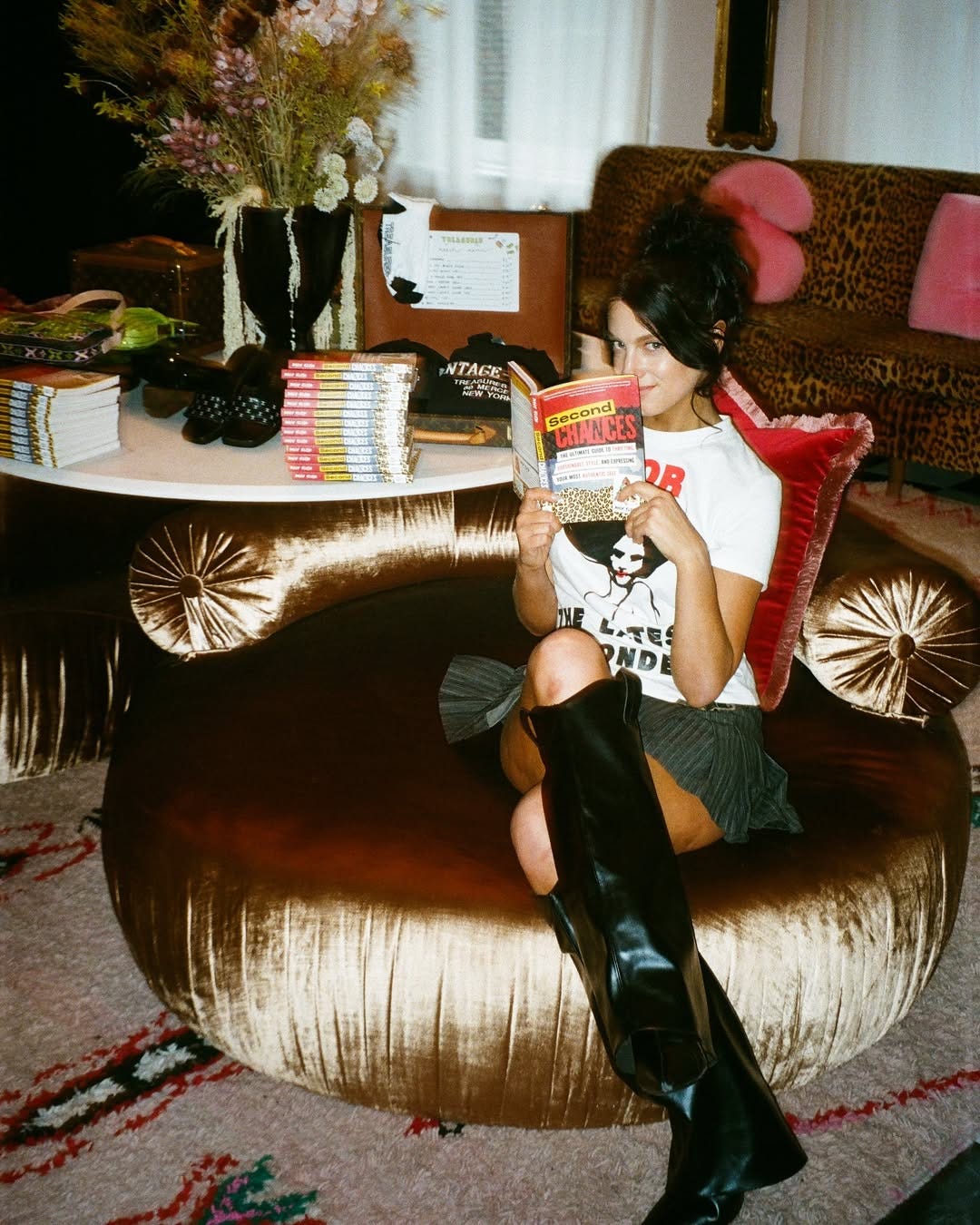in conversation with macy eleni
a chat with the high priestess of the pre-loved on her tiktok thrifting empire
Macy Eleni is living proof that rifling through bins — albeit Goodwill ones — can, in fact, be a career. With her guide to secondhand shopping, Second Chances, now in print and half a million followers watching her every rummage, she’s social media’s patron saint of secondhand style and the only person alive who can pull Miu Miu out of a Cincinnati antique mall. Here, Worn chats to Macy about thrift karma, the thrill of the hunt and the curious power of a handbag that reads “I ❤️ Botox”. Spoiler: it’s not for sale.
Worn: Tell us about yourself!
Macy: I live in Los Angeles but I’m originally from Dayton, Ohio. It’s an unremarkable place with no fashion scene and, growing up, I never felt I could properly express myself. I was a fish out of water. A lot of people feel deeply connected to their hometowns, but from the earliest age, I felt this pull toward Los Angeles. I knew I needed to be somewhere else. The things I dreamed about — fashion, entertainment — didn’t resonate with anyone around me.
I studied fashion merchandising at Ohio University, but I never felt I was finding my footing. The curriculum was incredibly outdated and, although it was great if you wanted to be a buyer at a department store, it didn’t reflect how the industry was moving. I’d been thrifting my entire life and was raised by a single mum. Long before I was posting online, I was in my local Salvation Army buying all clothes to try and recreate the looks I’d seen in magazines.
I moved to Los Angeles in 2016. In 2020, I started my TikTok and began posting videos about thrifting. It hit a nerve with people. It was surreal because, for so long, shopping the way I do was seen differently. It was something I was made fun of for because people didn’t understand it. It’s been extraordinary to watch the fashion world wake up to the fact that this is the direction we absolutely have to be heading in. It’s not only more sustainable but more expansive, cooler, and, to be honest, far more interesting than anything new.
Worn: So much has changed! Have you seen that reflected on your own For You page?
Macy: When I started making TikToks — I remember filming my first “come to an estate sale with me”— no one was doing that. I open my TikTok today and it's all thrift content. When I first started making videos online, it didn’t feel like there was a space for secondhand fashion creators, but there are so many people now who know they can create content through a solely secondhand lens, and that’s exciting to me.
I know some people feel mixed about secondhand becoming more popular but I think it’s incredible. A lot of us exist in this thrifting echo chamber, and because that’s what we’re consuming and the people around us are doing the same, we think, Oh my god, everyone’s thrifting now! Sometimes, I’ll have a video go a little more viral than usual, and the comments say it’s disgusting. I’m reminded that, actually, thrifting is still far from the norm. For most, buying something used still feels unfamiliar.
Worn: You’re absolutely right — it does feel like a bit of a bubble, doesn’t it? Inside the community, it’s easy to believe everyone’s on board, when really, most people still think secondhand means second best. Funnily enough, it’s often those within the world of thrifting who are the most precious about it growing. When did it first start to feel like your platform could become your job?
Macy: I had always been working on it in some way. I started a YouTube channel before TikTok and was posting casual videos there. By 2020, I had 30,000 subscribers on YouTube and was juggling freelance editing, assisting celebrity stylists, and working at a tanning salon, earning below minimum wage, while doing content creation on the side. It was full hustle mode.
When lockdown happened in 2020, I finally had the chance to pour everything into myself. TikTok changed everything. I hit 100,000 followers within a few weeks of posting, and I believe that is because I was not making content that followed the trends. I was not using the shortest video formats or the popular audio clips. My videos were the opposite. I would narrate an entire “thrift with me,” tell a story, and those videos began getting millions of views. It proved that the way I love to tell stories — through secondhand clothing — actually resonated. There was an audience. There was demand. It was not about quick dopamine hits or Amazon hauls. It was slower and more thoughtful.
I landed my first brand deal within a month or two. Since we were all stuck indoors, I had nothing but time to devote to it. That was the moment I realised this was not a side project but exactly what I had always hoped to create. My dream has always been to make fashion television. I wanted something more inclusive, more compassionate, more human than the fashion TV I had grown up watching that was so often about mocking someone into looking better, or giving them a “makeover” using clothing from department stores they would never be able to afford again. I always felt the real magic was in the thrift world and in the stories and possibilities those clothes offered. It had never been given a proper stage within fashion media, and that might be because the people who shop secondhand do not tend to look or live like the people positioned at the centre of the fashion industry.
Thrift communities are made up of low- and middle-income people, of all ages and all backgrounds. That variety is something I cherish. My audience is diverse. Unlike many of my influencer friends, whose communities often mirror their own style, mine reflects the people who actually make up the secondhand world. I have always known, deep down, that I was meant to speak to those people — the ones fashion had never spoken to at all.
Reaching that first 100,000 followers on TikTok confirmed what I had long believed. There were others out there who shopped as I did. Younger people in particular — Gen Z especially — care deeply about where their clothes come from, how they are made, and what impact they are having on the planet. That marks a change from previous generations, who lacked the social media platforms that now reveal the reality of sweatshops and garment worker exploitation.
The moment was not simply about going full-time. It was more a realisation that I had always known this was right, and that the world had finally started to catch up. The timing felt almost divinely aligned. I was making the same kind of content I had always made. What changed was that people were, at last, ready to listen. They were listening because this is the direction we need to move in.
Worn: When I was putting together a research file for Worn, I trawled through every book and film I could find on vintage and secondhand shopping and honestly, it was slim pickings. Most of what turned up felt terribly dated. Was that part of what drove you to create your book — the sense that something fresh was sorely missing?
Macy: There really isn’t much out there. When I got the opportunity to make my book, I felt so privileged. I set out to make a book that felt current, something that reflected the way we engage with secondhand fashion now. I went through the same thing you did when I started writing. I had to look for comparative titles, and everything I found was so dated, so dry, and so uninspiring.
The thrift and secondhand community — not just in the US, but globally — is so colourful, so creative, and full of life. It’s made up of some of the most inventive people in the world, often because they've had to make something out of nothing. That kind of necessity breeds such originality and that’s something mainstream fashion often lacks. Mainstream fashion puts up so many barriers to entry. If you can’t afford to take an unpaid internship — like I couldn’t — or if you don’t come from a background that gives you access to the industry, you’re effectively locked out. The secondhand world opens that door. That’s what I wanted to spotlight in the book.
Worn: You’re so right in that it’s not solely a matter of filling a gap on the shelf but about giving shape to a community that’s so often overlooked. Your book centres around the people behind the clothes. Was that part of your vision, to make something that felt as representative as it is referential?
Macy: I mean, that’s great for something, but it’s not what we’re trying to get into here. I was determined to make my book visual. I’m a visual person and I wanted the book to give off a vibe without needing to read a single word. I wanted it to be something you could read cover to cover and take away something meaningful. My goal was for it to speak to as many people as possible, in whatever way they connected with it.
Worn: It absolutely did! I read it in one sitting. I hadn’t crossed paths with your content before, though I suspect that’s because my algorithm hadn’t quite caught on to secondhand fashion at the time. It’s thoroughly attuned now. Once the algorithm finds you, that’s it, you’re in. There’s no going back, is there?
Macy: That’s so lovely to hear. So many people have told me they read it in one sitting. I wanted it to be a conversational read. It’s funny though because it took me years to write, and when I see people flying through it, I’m like, Wait, that’s it? It feels so short now! What I love is that you can open up any page and take something from it. I wanted it to feel like it was written for you. You know what I mean?
Worn: Absolutely. One of the things I enjoy most about your platform is how effortlessly you capture the thrill of the hunt. That, for me, is the real joy of secondhand shopping. Traditional retail is terribly efficient but thrifting is uncertain. You decide what you are after, but there is every chance you will not find it, and somewhere along the way, you fall in love with the chase. Eventually, the appeal of clicking and buying loses its charm. Is that something that resonates with your audience?
Macy: You start out thrifting and suddenly you find yourself immersed in this community of people who are genuinely excited about shopping this way. It really is so much fun. Like you said, you might start out looking for one specific thing and not find it for weeks, maybe never. Along the way, you end up discovering so many other things you didn’t even know existed. You start exploring shops, websites, and spaces you’ve never been to before and I think people are waking up to that magic.
That was one of the best parts of my book tour. I travelled to different cities across the country, and instead of holding events at bookstores, I held them at vintage stores run by my followers. It was amazing. I ended up in places like Kentucky and other small towns I’d never visited before, digging through antique shops and finding the most unexpected treasures. It was so much fun.
Worn: When you’re in unfamiliar territory, what is your approach to thrifting? I know from your book that you have your tried-and-true spots in L.A., but when those aren’t an option, how do you go about unearthing the good stuff?
Macy: It depends. I usually have loads of recommendations stored up because people are always messaging me tips and suggestions, but if I’m in any new city — whether I’m on vacation or just passing through — I’ll literally search “thrift stores” and start combing through them all. I check the reviews, of course, but more than anything I follow my instinct and I go where I feel pulled.
I love antique malls. Here in the U.S., they’re often thought of as places filled with old furniture which is why they’re great, because no one thinks to look there. That’s where I’ve found some of my best pieces, like a pair of 1990s Miu Miu runway shoes I discovered in an antique mall in Cincinnati for under $100. This woman had left them there, surrounded by the most random furniture. She told me, “I knew someone would want them one day — they’ve been sitting here forever.” I thought, how did Miu Miu sit here this long? That’s the magic. It’s always in the places you least expect.
Worn: When you stumble upon something tempting, how do you decide whether to carry it home or leave it behind for someone else? Is the act of giving back just as much a part of thrifting as the thrill of taking?
Macy: That’s been a learning curve that’s come with age and experience. When I was sixteen, I bought everything. If something even slightly caught my eye — like a puff-sleeved 1980s dress — I had to have it. That’s part of the process. When you’re new to thrifting, you should thrift your heart out. It’s how you discover your personal style.I’m 32 now and I know what I like. My style leans heavily toward the ’90s and early 2000s. I have my staples, so when I see something that I love, I’ll usually take a photo, have a little moment with it, carry it around in my cart for a while, but often, I’ll leave it behind.
I believe in thrift karma. The thrifting community thrives when everyone contributes rather than takes. I ask myself honestly: Will I actually wear this? Will I make space for it in my wardrobe? If the answer is no, I leave it for someone else to find. That said, I’m not judgmental about it. I’ve had plenty of moments where I thrift something and then re-donate it or give it to a friend. Of course, there are pieces I’m holding onto that I haven’t worn yet, but I know I will. Still, I try to see leaving things behind as a way to give back and trust that someone else will stumble upon it and fall in love. They might wear it every day, and in that way, you’ve had a hand in passing that piece along. A quiet nudge from the thrift gods.
I always say: switch from a scarcity mindset to an abundance mindset. People ask me all the time how I get so lucky thrifting. I think it’s because I believe I’ll find good things and I constantly circulate my wardrobe, giving back so that new treasures can come in. If you shift your perspective and realise it’s not just about you — that this is a community — that’s when it starts to feel truly circular, and that’s what makes it work.
Worn: Are you someone who likes to arrive early when thrifting? Do you find there is any real advantage to being first through the door?
Macy: Oh yes, but I’m also a Virgo and a little intense. I’ve always been a morning person, and I love being the early bird. During that first hour in the thrift store, when it’s just you, one other obsessive shopper, and the staff, it’s perfect. You can be in your own head before the crowd arrives. When I know I’m going thrifting, I wake up visualising what I’m hoping to find. I’ve got my espresso, my list, and I’m ready to manifest. That said, there’s really no bad time to thrift. Stores are always putting new things out. In the book, I mention that if you can’t go in the morning, the early evening is another great time. Most people are home with their families, so stores are quieter and you might even luck out and find gems that other shoppers picked up and then put back throughout the day.
Worn: You often speak about giving pieces back, but I imagine there are a few treasures you could never bring yourself to part with. Are there any items in your wardrobe that are firmly off-limits, no matter what?
Macy: Absolutely. Some of my most special designer finds are staying with me forever. Here, let me show you — first, there’s my iHeart Botox bag — it’s become iconic in my videos. I’ve never been asked about anything more. I did a radio interview with Ryan Seacrest and that’s what he wanted to talk about! There’s no label inside. I found it years ago at a friend’s vintage shop, and there’s no doubt in my mind it’s the only one of its kind. People have offered me thousands for it, but I’ll never part with it. It’s worthless, in theory, but priceless to me.
There are pieces like my Louis Vuitton Murakami bag, the older style they didn’t reissue in the recent collection. I found it for an absurdly good price at a vintage store in Miami. It’s the kind of thing I’d dreamed about since I was fifteen, flipping through People Magazine, seeing Paris Hilton snapped with it. To find it years later, secondhand, felt like a full-circle moment.
I’m in a different financial place now than when I started thrifting at sixteen but I still hold to the same principles. I just can’t justify spending thousands on an item when I know it’s out there, waiting for me, secondhand. It’s a mindset my mum instilled in me and one I’ve taken to heart. That delayed gratification — the journey to the find — is something I’ve come to romanticise.
There are quirkier pieces too, like these sneaker heels I’ll never part with, or a tank top I picked up at an estate sale for a woman who produced How to Lose a Guy in 10 Days. It reads: Stop bitching, start a revolution. Apparently, she used to wear it around LA back in the day. Iconic. They’re not designer, but they carry this energy, this story, and that’s just as valuable to me.
Worn: Estate sales feel very Los Angeles. After reading about them in your book, I found myself hunting around to see if we had anything similar in London. Nope.
Macy: I hear that a lot from my UK followers. Estate sales are common across the U.S., but Los Angeles is special because of the kinds of people who’ve lived here. I once went to the estate sale of Alex Trebek, the long-time Jeopardy! host. It was incredible. My friend bought his director’s chair. What’s special about estate sales is that you’re not just finding objects, you’re encountering their stories. It’s like thrifting with a biography attached. You carry that story forward and give it new life.
Worn: When you visit an estate sale, do you know whose home you’re stepping into, or is that part of the mystery?
Macy: Sometimes they’re private, and the company handling it can’t reveal anything, and on others you get the full backstory — often more than you bargained for.
Worn: How do you go about finding them?
Macy: It’s simple. Here in the States, we have yard sales and garage sales. I don’t know if that’s a thing in the UK?
Worn: Not quite garage sales, no. Ours tend to take place in damp fields at an ungodly hour.
Macy: Ah, so more market-style. Well here, if people are clearing out, they’ll do it right in their garage or on the lawn. Estate sales are like that but the entire house is up for grabs. I use estatesales.net. You enter your zip code and it shows you all the upcoming sales nearby. They’re usually free to attend. You turn up, maybe queue early if you’re keen, but it’s very relaxed.
Worn: I would love to experience one. There are so many brilliant things in America that don’t exist over here!
Macy: Well, we’re a little crazy. We’ll throw ourselves into piles of clothes. There’s endless ways to shop, but, you’ve got to love it…


